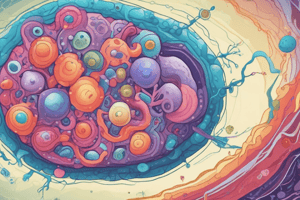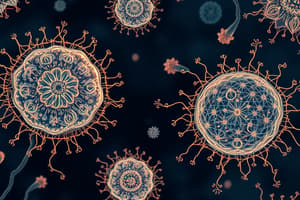Podcast
Questions and Answers
Which of the following correctly describes prokaryotic cells?
Which of the following correctly describes prokaryotic cells?
- Contain multiple linear chromosomes
- Possess a true nucleus
- Are generally small with single, circular chromosomes (correct)
- Have membrane-bound organelles
What is the primary composition of the cell membrane?
What is the primary composition of the cell membrane?
- Nucleic acids and carbohydrates
- Peptidoglycan and phospholipids
- Lipids and proteins (correct)
- Cellulose and chitin
In what way do eukaryotic cells divide?
In what way do eukaryotic cells divide?
- Binary fission only
- Fragmentation and budding
- Mitosis and meiosis (correct)
- Budding exclusively
Which of the following is true about the cell wall in plant cells?
Which of the following is true about the cell wall in plant cells?
What distinguishes eukaryotic cells from prokaryotic cells regarding organelles?
What distinguishes eukaryotic cells from prokaryotic cells regarding organelles?
Flashcards
Prokaryotes
Prokaryotes
Simple, single-celled organisms without a nucleus.
Eukaryotes
Eukaryotes
Complex cells with a defined nucleus and organelles.
Cell Wall
Cell Wall
Rigid outer structure in plant and bacterial cells that provides shape.
Cell Membrane
Cell Membrane
Signup and view all the flashcards
Chromosome Structure
Chromosome Structure
Signup and view all the flashcards
Study Notes
Prokaryotes vs. Eukaryotes
- Prokaryotes:
- Generally smaller cells
- Lack a nucleus
- Have a single, circular chromosome
- Lacks membrane-bound organelles
- Cell division by fission or budding
- Eukaryotes:
- Generally larger cells
- Contain a nucleus
- Contain multiple linear chromosomes
- Contain membrane-bound organelles
- Cell division by mitosis and meiosis
Cell Structure
- Cell Wall (Plant cells):
- Rigid, non-living structure
- Made of cellulose
- Provides shape and support
- Cell Wall (Bacterial cells):
- Made of peptidoglycan
- Cell Membrane:
- Also called the plasma membrane
- Outer covering of animal cells
- Located inside the cell wall in plant cells
- Thin, elastic, living
- Double layer
- Permeable
- Primarily composed of lipids and proteins
- Major lipids are phospholipids arranged in a bilayer
Cellular Features
- Nucleus:
- Contains chromatin (DNA and histone proteins)
- Contains a nucleolus
- Nucleolus:
- Located inside the nucleus
Studying That Suits You
Use AI to generate personalized quizzes and flashcards to suit your learning preferences.




